Teamwork is very important in today’s aggressive business world. Effective technologies are necessary to support and facilitate communication and effective working schedules of a team. Whether you have remote workers or have employees in the office, the Collaboration solutions ease work processes, focus all communication, and enable teams to succeed. In this ultimate list, you will discover the 15 Best Collaboration Tools with their key features, advantages, and cost estimates. Find out how these tools can help your teams to be more productive on their tasks.
What are the Collaboration Tools?
The Best Collaboration Tools are applications that can help users to share information, and documents, and work in real time. They serve all kinds of businesses so that each team gets to collaborate optimally irrespective of the distance. They include facilities such as chat, video, and voice calls and, the ability to share files and check on project progress, which help in avoiding bottlenecks. Some of the most used tools include Slack, and Microsoft Teams, Asana which suit different collaboration requirements.
Advantages of the Most Effective Collaboration Platforms
- Enhanced Communication: Very importantly, centralization keeps all members of the team on the same page, thus minimizing confusion.
- Increased Productivity: Computerized assignments, document exchange, and project monitoring help to reduce time and facilitate processes.
- Remote Work Support: Enables team working across a large organization with multiple departments and locations to support business operations.
- Real-Time Updates: Real-time information delivery and permission-based real-time editing help to maintain the update.
- Cost Efficiency: Minimizes occasions for physical contacts and travel which are costly.
List of the 15 Best Collaboration Tools
1. Slack

Slack is an all-in-one communication solution that is intended to unify teams so that they can work efficiently in channels and real-time messages. It is therefore easy to navigate, due to its user-friendly working interface that can work well with any business. They can be configured by projects, teams, or topics so that work within them stays on track.
Key Features
- Channel Organization: Use project, team, or topic-specific channels for your work.
- Third-Party Integration: This is well-integrated and compatible with over 2400 applications, such as Google Drive and Trello.
- Search Functionality: Search history for their capability to move faster as well as access special chat and document histories.
Pros
- Intuitive interface.
- Made for every type of business, big and small.
- The options for incorporating analytics into your business strategy are the best in this segment.
Cons
- In the free edition, the amount of features they offer is small.
- If you read notifications you will find them to be numerous.
- All the tests are integrated with internet connectivity.
Ideal For: To date, where startups, remote teams, or enterprises require a centralized mode and means of communication.
Pricing: Free version available. Small business plans pricing: basic – $7.25 user/month.
Rating: 4.8/5
Website: www.slack.com
2. Microsoft Teams

Microsoft Teams is an extensive workspace that is fully compatible with Microsoft 365, previously known as Office 365. Integrated features include the use of chat, video, share files and manage tasks within a single application. Integration with other apps such as Microsoft Office apps like Word, Excel, and PowerPoint means that the Teams users can actually edit papers within the app.
Key Features
- Video Meetings: Share HD videos with up to 1000 participants during your HD video conferences.
- File Sharing: Flow smoothly the files within the app, as well as collaborating on the documents.
- Task Integration: Integrations for other built-in tasks such as the Planner.
Pros
- Here, one of Lync’s strong points is a tight integration with other Microsoft Office applications.
- Robust security features.
- Recommended for organizations large enough to support their capital investments.
Cons
- The key drawback of this concept is that it has rather limited functionality when it comes to offline access to resources.
- Complex setup for new users.
- It is essential to mention that some of the features presented here are available only due to the free trial of Office 365.
Ideal For: Students, enterprises and working teams are already using Microsoft Office Suite.
Pricing: Free version available. There are options for subscriptions with precise per-user pricing; the basic plan costs $4 per user per month.
Rating: 4.7/5
Website: www.microsoft.com/teams
3. Trello

Trello is best described as a project management software in that it is an application that enables one to set up project workspaces that capture and track tasks in a manner that is reminiscent of a Kanban board. Each project can be divided into boards, lists, and cards according to the user’s needs – it is perfect for one’s small task as well as for a large-scale activity in a team.
Key Features
- Kanban Boards: Worst of all, it enables one to draw plans on systems and quickly track project progress to particular phases.
- Power-Ups: Slack, Google Drive, and Evernote compatibility to bring more value and improve usage.
- Automation: Organize your work streams effectively with Trello using the Butler function.
Pros
- User-friendly programs can particularly be applied by people with little or no prior knowledge about using such programs.
- Instant updates to support flawless cooperation among members of a particular group.
- As already mentioned, very flexible depending on project-specific needs.
Cons
- They retained the advanced features of the upgrade, making the free version not that equipped.
- Not suitable for very large projects that require more than one screen.
- It can be difficult to get enough financial information or report, as needed for analysis.
Ideal For: Particularly, successful for small and middle-sized teams who don’t need complex software to manage their tasks.
Pricing: Free version available. The free plan is available but paid plans begin from $5 per user monthly.
Rating: 4.6/5
Website: www.trello.com
4. Asana

Asana is an open, customizable platform that can be used to plan, monitor, and prioritize work for any team. It equally allows the effective management of various tasks using tools such as Kanban boards, timelines, and a calendar layout. Some of the advanced features available from Asana include; the assignment of tasks, any dependencies, and any due notification to ensure deadlines are met.
Key Features
- Timeline View: Project timelines correlate to the development of visual representations that enable projects to run smoothly.
- Task Assignments: Make up assignments with due dates and dependencies.
- Integrations: Integrates with over 100 apps compatible with Slack, Google Workspace, and many others.
Pros
- It is rather useful for organizing large and intricate assignments.
- Simple tracking of activities and subactivities.
- It encourages the integration of multiple teams in an organization, for instance, functional teams.
Cons
- Huge steps for a beginner to go through.
- Some of the amazing features are associated with the paid subscriptions.
- The presented work highlights that the functionality of mobile applications is less diverse.
Ideal For: Individuals who are managing a project that involves several steps that have a proper timeline.
Pricing: Free version available. Pricing for the service begins from $10.99 per user per month for the paid features of the service.
Rating: 4.7/5
Website: www.asana.com
5. Zoom

Zoom is a famous digital platform that provides video conferencing services with fast and free-shared audio and video quality. Among them we can find: video conferences in HD quality, sharing of screens and content, as well as facilities for creating subgroups or «breakout rooms» that make Bing Talk a suitable tool for disconnected teamwork. Zoom’s capabilities allow meetings with participants of up to 1000 people at once and webinars with up to 10,000 participants concurrently.
Key Features
- Video Conferencing: Allow the hosting of HD video meetings with up to 1000 participants.
- Screen Sharing: Screens should be shared during presentations or any work that requires collaborative use.
- Breakout Rooms: Help chair a small group during large meetings.
Pros
- Robust and sustainable system.
- Easy to operate by coming with an easy-to-understand interface.
- Fits for holding extensive conventions and web conferences.
Cons
- Depends on an internet connection, and needs a reliable internet connection for it to function effectively.
- It is free but the availability of meetings is limited to 40 minutes only.
- Security considerations in the past.
Ideal For: Non-stop telecommuting, distance education, and webinars.
Pricing: Free version available. Pricing for the paid plans begins at $14.99 per month per host.
Rating: 4.8/5
Website: www.zoom.us
6. Monday.com
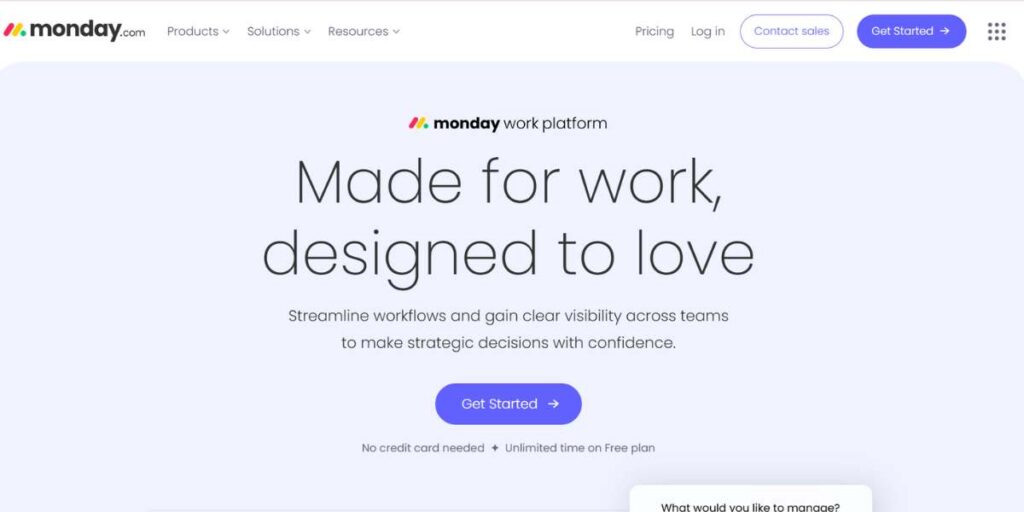
Monday.com is one of the flexible work management tools and what makes it unique it was created to improve the work process. With different interface layouts, users can easily monitor their workflows, visualizations, and organization plans. It has a feature of automation, allowing the user to set up events that occur again and again, such as notifications or changes of status.
Key Features
- Customizable Dashboards: More specifically, it is possible to tailor the employed dashboards to visualize the data and track progress properly.
- Automation: Do that automatically, send notifications and status updates, and so on.
- Integration: Compatible with applications such as Slack, Zoom, and even Microsoft Teams.
Pros
- Able to be highly customized to different working environments.
- Perceives that there are instances when automation of a process is desirable.
- Contain detailed analysis of work progress and generating reports.
Cons
- The quality plans in most cases are costly.
- Initial configuration takes time and knowledge on the part of the staff.
- Could be quite a challenge when undertaken by a small team.
Ideal For: Teams with a higher level of rigid work and heavy usage of technology.
Pricing: Free trial available. Business plans begin at $8 per seat per month or $240 per year per seat.
Rating: 4.7/5
Website: www.monday.com
7. Notion
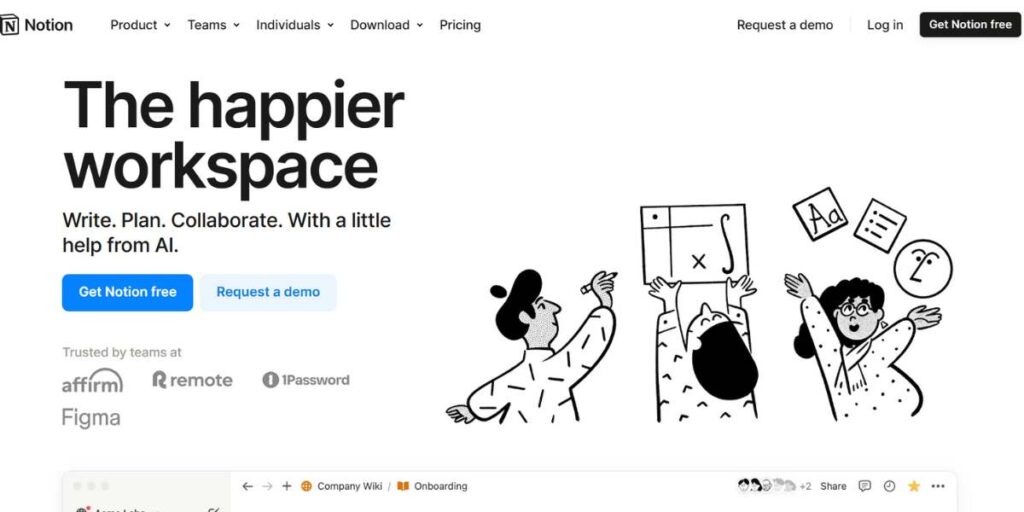
Notion is a highly versatile workspace and note-taking app with features of a to-do list and document-sharing platform. It is created to support as many scenarios as possible, starting with personal planning and ending with collaboration and knowledge management. The platform lets users establish proprietary relational databases and is best suited to coordinating deliveries, timetables, and project details.
Key Features
- Database Management: Make and edit relational databases quickly.
- Customizable Templates: Pre-defined templates should be used when performing tasks, calendars, and projects.
- Best Collaboration Tools: Present and modify documents simultaneously.
Pros
- Very suitable for various processes in different fields of work.
- A lot of choices in terms of customization.
- It gathers several appliances in one place.
Cons
- Takes time to comprehend the higher functionalities of this product.
- This way, mobile apps could be more user-friendly.
- Some of the weaknesses include inadequate development of a project status report.
Ideal For: Freelancers, start-ups, and creatives.
Pricing: Free version available. There are paid plans available right from $8 per user, per month.
Rating: 4.6/5
Website: www.notion.so
8. Google Workspace (earlier called G Suite)
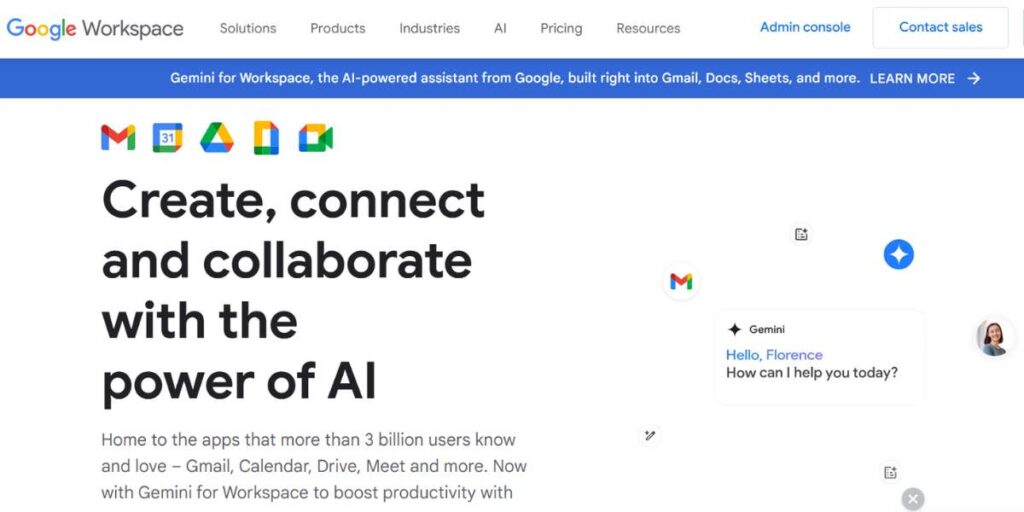
Google Workspace is an all-inclusive platform of applications and tools aimed at increasing efficiency in cooperation processes. Some of the most frequently used software are Gmail, Google Drive, Docs, Sheets, and Meet all designed to work together for better team productivity. That is one of the most significant benefits of using Google Workspace is collaboration in real-time.
Key Features
- Real-Time Collaboration: Co-authoring lets you work with others on a document, a spreadsheet, or a presentation at the same time.
- Cloud Storage: Keep and retrieve documents safely on any device.
- Video Conferencing: Google Meet for top-quality and very effective virtual meetings.
Pros
- Completely versatile, you can use it from any cloud.
- Outstanding for usage in working on the same document.
- Applicable to large and small enterprises.
Cons
- Ions unavailable that rely mostly on Bluetooth technology: Limited functionality when used offline.
- Some of these extras may cost extra.
- May need a certain degree of knowledge because the interface might be rather complex for certain people.
Ideal For: Organizations that require linked efficiency and connection solutions within as well as across their teams.
Pricing: A free version for individual users is also available. Price plans start at $6 per month per user.
Rating: 4.8/5
Website: https://workspace.google.com/
9. Basecamp
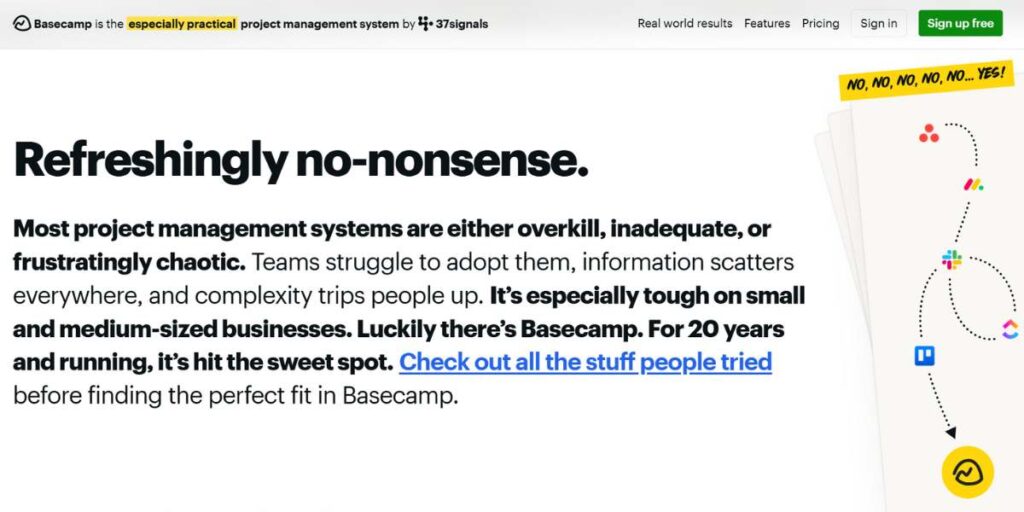
Basecamp is a simple-to-use project management solution for the purpose of integrating communication, task, and file sharing. Due to its simplistic design, the tool is ideal for use by small business entities and employees in remote workplaces. The main elements of Basecamp are message boards for paragraphs of discussion, to-do lists to keep track of tasks, and file sharing to store common working files.
Key Features
- Message Boards: Always retain control over all your conversations with others.
- To-Do Lists: Make to-do lists and virtually assign due dates.
- File Sharing: Each user can upload and share documents and files simply.
Pros
- Easy to use and friendly user interface portrayals.
- No charges are incurred on the number of users; users subscribe at a given flat fee.
- Well-suited for remote workers and small businesses.
Cons
- Not equipped with some of the sophisticated tools to handle large projects.
- Relatively few choices to tailor the vehicle.
- No time-tracking feature.
Ideal For: Individuals, small companies, and teams that only require simple project management tools.
Pricing: This tool is free of charge for personal use with a free plan available for software download. Paid plan: $99/month (flat rate).
Rating: 4.5/5
Website: www.basecamp.com
10. Dropbox
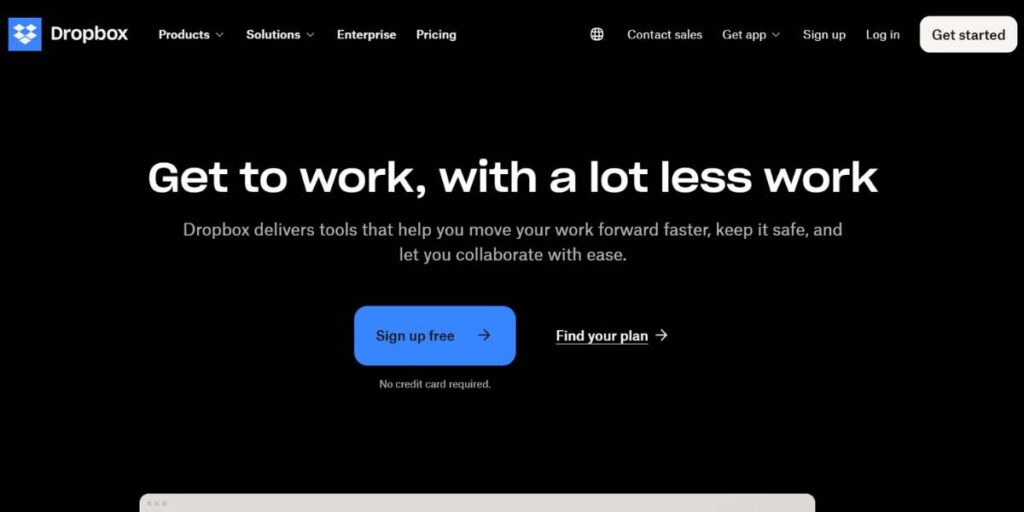
Dropbox is a popular file-synchronizing and sharing company that makes file sharing and management more secure. It comes in handy for integrated teams meaning it is suitable for departments that work with bulky documents and require moving across various devices. By syncing all the files that the teams work on, Dropbox makes any update visible to all members of the teams.
Key Features
- File Synchronization: One can view updated files on every single device.
- Team Folders: One place where everyone can access documents or projects that are created for the project but owned by more than one person.
- Integration: Integrated with widely used applications such as Slack and Zoom.
Pros
- Simple to use tool for sharing files between different users.
- Volume throughput, massive scale, open API, ultra-low latency, advanced networking, powerful computing capability, and secure system.
- Supports large file uploads.
Cons
- Small space is available for storage in the open version of the plan.
- Becomes costly for large teams.
- Originally designed to be for file organizing and not time tracking.
Ideal For: Teams that need more file security and less file sharing hassle.
Pricing: Some core features are free to use but basic; they include a 2GB storage capacity. The paid plans begin from $12 per month and per user.
Rating: 4.6/5
Website: www.dropbox.com
11. ClickUp
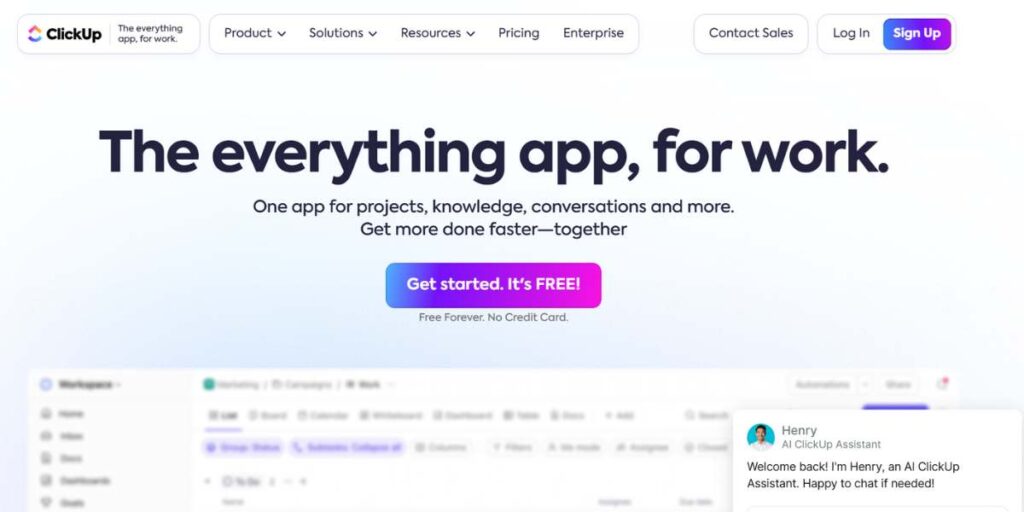
ClickUp is a very flexible productivity tool that has a comprehensive set of tools for task management and project management. First and foremost it is adaptable – you can set down a certain number of stages that you think will be required to complete the workflow, and then extend it and add more stages if it is needed. Kanban, list, calendar, and Gantt chart views are available in ClickUp making it easy for teams to have a view of their projects.
Key Features
- Customizable Views: Select between the Kanban mode, the list mode, and the calendar mode.
- Time Tracking: Monitor time spent on tasks.
- Automation: Reduce routine and frequent activities conducted within an organization.
Pros
- It is relatively flexible and can easily feature significant changes.
- Comprehensive free plan.
- As leads in the project, they are excellent for both simple and complicated projects.
Cons
- Overwhelming especially for the new users of the system.
- Mobile apps need improvement.
- Sometimes optional features can only be used under upgraded accounts.
Ideal For: Teams that are involved in several processes with different requirements for a tool.
Pricing: Free version available. The paid plans begin at $5 for users per month.
Rating: 4.7/5
Website: www.clickup.com
12. InVision

InVision is specifically designed to be an engaging solution for design teams. It simplifies the design process by having features for creating prototypes, gaining feedback, and managing projects hence assisting organizations in realizing the ideas of their teams. InVision’s strength is the ability to create an interactive prototype based on web and mobile applications.
Key Features
- Prototyping Tools: Design live clickable mockups for web and app interfaces.
- Real-Time Collaboration: Facilities for the team members to interactively discuss, view, and modify the designs.
- Centralized File Management: Acquire modern copies of the design in one location.
Pros
- Highly suitable for teams whose priority is the design.
- Enables the provision of refined feedback loops, which can enhance the designs.
- It is a much better tool to foster communication between designers, developers, and stakeholders.
Cons
- Not suitable for use on other types of affairs that do not involve design in any way.
- The initial learning curve that is foreseen to be recommended to first-time customers.
- Some features can only be availed at appealing value, especially for small teams.
Ideal For: Design organizations and work groups trying to enhance the effectiveness of creative integration practices.
Pricing: Pricing starts with a freemium plan with a handful of capabilities. Professional editions begin at $4.95 per user per month with the Pro offering.
Rating: 4.6/5
Website: https://miro.com/
13. GitLab

GitLab is a very powerful technology that is used by development teams as a platform to organize work, manage projects, and collaborate. SCM integrates source code and the continuous integration and delivery process of the organizational structures with extensively developed Best Collaboration Tools.
Key Features
- Version Control: With Git-based repositories, ensure the management of the code changes.
- CI/CD Tools: Minimize the amount of testing, building, and deploying that can be done manually.
- Issue Tracking: It keeps track of tasks, bugs, and even the milestones of the project within one project management system.
Pros
- Software life cycle management tool that supports multiple Development and Operations processes.
- A great emphasis on security and compliance issues.
- An open-source version of the software is available which can be hosted on an organization’s infrastructure.
Cons
- Most relevant to development teams, is exclusion from other teams’ work because of its customer focus.
- Full-featured console which might be confusing for new users not acquainted with the Git system.
- Some of its functions are available only in case you pay for the additional utilities.
Ideal For: DevOps professionals, IT specialists, and companies working on development, software delivery, and deployment.
Pricing: The basic version is also free of charge with limited functionalities. Some of the plans are paid, and the Premium plan will cost $19 per user, per month.
Rating: 4.6/5
Website: www.gitlab.com
14. Zoho Cliq

Zoho Cliq is an interaction tool that is used in real-time with an emphasis on team communication coupled with integration with other Zoho products. It provides a great, friendly, and simple design, working functions, and comparatively low price, so it can be beneficial to organize cooperation between companies that don’t need complex software. Discussions are made easier by grouping them into channels and threads to bring order to the topic.
Key Features
- Real-Time Chat: Real-time chat is a communication tool enabling instant, live messaging between users over the internet.
- Video Conferencing: They also expected virtual meetings to have tools built into them.
- Third-Party Integration: Integrates well with the other Zoho apps as well as with applications outside the Zoho ecosystem such as Slack.
Pros
- Affordable pricing.
- Good compatibility with the rest of the Zoho software.
- Robust mobile app.
Cons
- The free version being offered lacks some of the interesting features.
- Some options need configuration.
- Not ideal for non-Zoho users.
Ideal For: Small teams that are already using Zoho products or those that don’t need complex media communication.
Pricing: Free plan available. There are also offered business plans starting from $3 per user per month.
Rating: 4.6/5
Website: www.zoho.com/cliq
15. Confluence

Confluence by Atlassian is a simple and powerful knowledge management tool for creating and sharing team content. Because of its structured framework, TAP is perfect for documentation, project preparation, and collaboration of centralized information. This is leveraged into Confluence with features that enable teams to build and edit the documents simultaneously.
Key Features
- Content Collaboration: Be able to work on producing documents or modify them at the same time in real-time.
- Templates: Employ preexisting templates within the company for future reports, meeting notes, and project planning.
- Integration: More information about integration abilities with other applications and services such as Jira, Trello, and other Atlassian products.
Pros
- Usable for knowledge sharing and also in documentation processes.
- Scalable for growing teams.
- Integration with some of these tools seems to be very tight.
Cons
- The tighter available storage space in the basic ‘flavors’ of computers with drives connected.
- May be a little complicated for a beginner to handle.
- Paid subscriptions may attract slightly higher costs than market standard as would be observed in the case of premium subscription plans.
Ideal For: Teams related to documentation and KM.
Pricing: The basic plan is free for only up to 10 users. From $5 per user per month, you can unlock features available in every one of the paid plans.
Rating: 4.5/5
Website: http://www.atlassian.com/software/confluence
Benefits Of Using the Best Collaboration Tools Correctly
Recourse to Best Collaboration Tools can have a vast positive impact on the teams’ performance and the efficiency of the collaboration processes. Here’s how:
- Define Clear Objectives: Set objectives for utilizing the tool, for instance, in communication, in managing activities, or in increasing project control.
- Onboard Your Team: Arrange programs and materials to increase the visibility and awareness of all people of the features and benefits of membership.
- Integrate with Existing Systems: To make it easier to work with, link it with a tool that is already being worked on such as email, CRM, or task-related software.
- Monitor Usage: Balance the utilization of the tool and assess the problems that the team encounters using the tool.
- Encourage Collaboration: Encourage free flow and safe sharing of information or feedback by the team members that is enhanced by the use of tools
Conclusion
What Best Collaboration Tools Look Like is essential for those companies willing to improve efficiency and optimize cooperation. Thus, across various business applications such as projects, management of meetings, or sharing files, all these solutions consider different wants. Focusing on the tools that have the potential to help teams enables them to work effectively and minimize overhead thus producing their deliverables effectively. Beginning to read through the choices presented here, individuals may identify one of the options as the ideal match for their organization’s needs and take business collaborations to the next level.
FAQs
1. What are the four principal categories of productivity tools?
The other ones include communication, task, document management, document sharing, and analytics solutions.
2. Which among the tools can be said to be the best for small businesses?
Alternatives such as Trello and Slack are relatively cheaper and easy to understand especially for a small working team.
3. Is it possible to have worth business collaboration using free Best Collaboration Tools?
Yes, for basic needs. Nevertheless, the additional options may open in paid subscriptions.
4. Which is the best solution for dealing with remote working?
While working remotely communication tools like Zoom, Slack, and Microsoft Teams are among the best to use.

